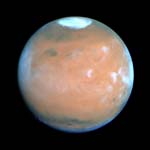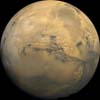
Introduction
Mars is the fourth planet from the sun. It is reddish and its visible disk
shows some light and dark patches with prominent polar
caps. These surface features undergo slow seasonal change over the course of
a Martian year.
It has a diameter 0.53 times that of Earth (= 6794 km), a mass of 0.11 Earth's
mass and a density of 3.90 g/cm3. It rotates once on
its axis in 24 hours 37 minutes.
Atmosphere
Mars has a very thin atmosphere. Its atmospheric pressure is 1/50 Earth's
atmosphere at sea level and its atmospheric temperature at summer time is about
300K at noon.

Terrain
Mars has hundreds of volcanoes including Olympus Mons,
which is the largest volcano in the solar system. Olympus Mons is 3 times taller
then Mt. Everest.
 The Martian canyons are deep, dwarfing the Grand Canyon. The Mariner Valley
(4000km long, 120km wide and 7km deep) is the largest canyon on Mars.
The Martian canyons are deep, dwarfing the Grand Canyon. The Mariner Valley
(4000km long, 120km wide and 7km deep) is the largest canyon on Mars.
 The Tharsis Bulge is a region near the equator. It is about the size of North
America and it bulges out about 10km higher than the rest of the planet.
The Tharsis Bulge is a region near the equator. It is about the size of North
America and it bulges out about 10km higher than the rest of the planet.
Moons
Mars has two rather tiny and irregularly shaped moons, Deimos (Panic) and Phobos (Fear). Deimos measures 16 km by 10 km and has a very large crater measuring 2.3 km across. It stays above any Martian's horizon for 2.5 mars days. Phobos orbits very close to Mars. It rises in the west and sets in the east after being up for 4.5 hours
Special Features - Running Water
There is evidence for running water on Mars, as can be seen from the runoff channels (dried up riverbeds) and outflow channels (relics of catastrophic flooding).